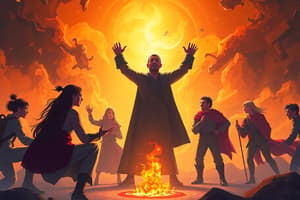Podcast
Questions and Answers
In the context of the MG414 group assignment, what marks Week 7 as a critical juncture?
In the context of the MG414 group assignment, what marks Week 7 as a critical juncture?
- The week dedicated to peer review and final revisions.
- The week when teams are formed, roles are assigned, and a structured plan is initiated. (correct)
- The week when the final report is due.
- The week when students receive their individual grades.
Aisha's natural inclination to lead, based on her confidence in organizing the team, aligns with which leadership theory?
Aisha's natural inclination to lead, based on her confidence in organizing the team, aligns with which leadership theory?
- Transformational Leadership.
- Expert Power dynamics.
- Trait Theory. (correct)
- Situational Leadership.
David believes leadership should adapt to the team's needs. Which leadership approach does this align with?
David believes leadership should adapt to the team's needs. Which leadership approach does this align with?
- Transformational Leadership.
- Expert Power.
- Trait Theory.
- Situational Leadership. (correct)
Elena advocates for a collaborative leadership approach, ensuring everyone is equally involved. Which leadership style reflects this?
Elena advocates for a collaborative leadership approach, ensuring everyone is equally involved. Which leadership style reflects this?
Liam believes his technical skills give him more control over research decisions, basing his influence on:
Liam believes his technical skills give him more control over research decisions, basing his influence on:
Disagreements in the group escalated primarily due to what factors?
Disagreements in the group escalated primarily due to what factors?
Zainab prefers to avoid confrontation and hesitates to push back when others don't meet expectations. Her behavior best describes which conflict management style?
Zainab prefers to avoid confrontation and hesitates to push back when others don't meet expectations. Her behavior best describes which conflict management style?
What key decision regarding leadership does the 'Decision Point' prompt the group to consider?
What key decision regarding leadership does the 'Decision Point' prompt the group to consider?
According to the 'Decision Point', what is one of the critical considerations regarding Liam's expertise?
According to the 'Decision Point', what is one of the critical considerations regarding Liam's expertise?
What does the Module Tutor emphasize as equally important as the quality of the research?
What does the Module Tutor emphasize as equally important as the quality of the research?
What key decision must the group make regarding feedback on their work?
What key decision must the group make regarding feedback on their work?
What is one of the benefits of verbal presentations compared to written peer feedback, as highlighted in the discussion prompts?
What is one of the benefits of verbal presentations compared to written peer feedback, as highlighted in the discussion prompts?
How does formative feedback improve team performance and report quality?
How does formative feedback improve team performance and report quality?
What skills does Week 7 aim to foster beyond just writing a report?
What skills does Week 7 aim to foster beyond just writing a report?
According to the Group Structuring Table, what is the purpose of documenting decisions and creating a structured framework?
According to the Group Structuring Table, what is the purpose of documenting decisions and creating a structured framework?
How does the structured decision-making table encourage alignment with theoretical concepts?
How does the structured decision-making table encourage alignment with theoretical concepts?
The 'Leadership Approach' section in the group structuring table provides:
The 'Leadership Approach' section in the group structuring table provides:
Under the 'Task Allocation Method,' what potential approaches are suggested?
Under the 'Task Allocation Method,' what potential approaches are suggested?
Why is 'Building team cohesion and ensuring responsibility' listed as justification for 'Accountability Measures'?
Why is 'Building team cohesion and ensuring responsibility' listed as justification for 'Accountability Measures'?
According to the table, what is a potential choice for the 'Conflict Resolution Plan'?
According to the table, what is a potential choice for the 'Conflict Resolution Plan'?
What elements are included in the 'Decision-Making Process'?
What elements are included in the 'Decision-Making Process'?
What impact does the choice of 'Group Presentation or Peer Review' have, according to the Group Structuring Table?
What impact does the choice of 'Group Presentation or Peer Review' have, according to the Group Structuring Table?
What potential measures can a group use to ensure accountability, as listed in the table?
What potential measures can a group use to ensure accountability, as listed in the table?
How should students utilize theories in their structured decision-making?
How should students utilize theories in their structured decision-making?
What main skills does the assignment encourage?
What main skills does the assignment encourage?
Flashcards
Situational Leadership
Situational Leadership
A leadership theory where effective leadership adapts to team needs; leaders change their approach based on the situation.
Task Allocation Conflict
Task Allocation Conflict
Escalation of disagreements due to unclear task assignments and approaching deadlines.
Expert Power
Expert Power
The ability to influence others based on specialized knowledge or skills.
Peer Review Process
Peer Review Process
Signup and view all the flashcards
Group Structuring Table
Group Structuring Table
Signup and view all the flashcards
Avoid Conflict
Avoid Conflict
Signup and view all the flashcards
Trait Theory
Trait Theory
Signup and view all the flashcards
Transformational Leadership
Transformational Leadership
Signup and view all the flashcards
Study Notes
- Students of MG414 Organisational Behaviour are at a crucial point in their group report assignment during Week 7.
- Teams need to form, assign roles, and create a structured plan.
- Challenges arise as the group starts working together.
Leadership Styles and Power Dynamics
- Aisha takes on a leadership role, believing strong leadership is key, following Trait Theory (Stogdill, 1948).
- David prefers a structured approach, advocating for Situational Leadership (Hersey & Blanchard, 1969), where leadership adapts to team needs.
- Elena promotes Transformational Leadership (Bass, 1985), emphasizing a collaborative approach.
- Liam believes his Expert Power (French & Raven, 1959) should give him more control over research decisions because he is the most technically skilled.
- Disagreements arise over decision-making processes and who has the authority to make final decisions.
Conflict and Decision-Making
- Disagreements over task allocation and deadlines become major sources of conflict.
- David wants strict deadlines, while Zainab, who prefers to avoid conflict (Thomas-Kilmann Model, 1974), hesitates to push back when expectations are not met.
- Key decisions include whether leadership should be formalized or emerge naturally, and whether to ensure an equal distribution of responsibilities.
Feedback Mechanisms
- The Module Tutor advises the group on the importance of teamwork and the quality of their research.
- An essential decision is how to receive feedback on their work, either through a group presentation or a structured peer review process.
Structuring Teamwork
- Document decisions and create a structured framework.
- Key Aspects to Formalize Group Organisation:
- Leadership Approach: Rotational, Single Leader, or Shared Leadership.
- Justification can be linked to Situational Leadership (Hersey & Blanchard, 1969).
- Task Allocation Method: Based on expertise, equal division, or flexible roles.
- Aligned with French & Raven's Expert Power vs. Shared Responsibility.
- Conflict Resolution Plan: Team discussions, mediation, voting, or compromise strategies.
- Linked to the Thomas-Kilmann Conflict Model.
- Decision-Making Process: Democratic vote, leader makes the final call, or consensus-based.
- Ties into power structures in teams.
- Feedback Approach: Group Presentation or Peer Review.
- Impacts self-reflection and improvement.
- Accountability Measures: Weekly check-ins, task tracker, or performance reviews.
- Builds team cohesion and ensures responsibility.
Studying That Suits You
Use AI to generate personalized quizzes and flashcards to suit your learning preferences.




